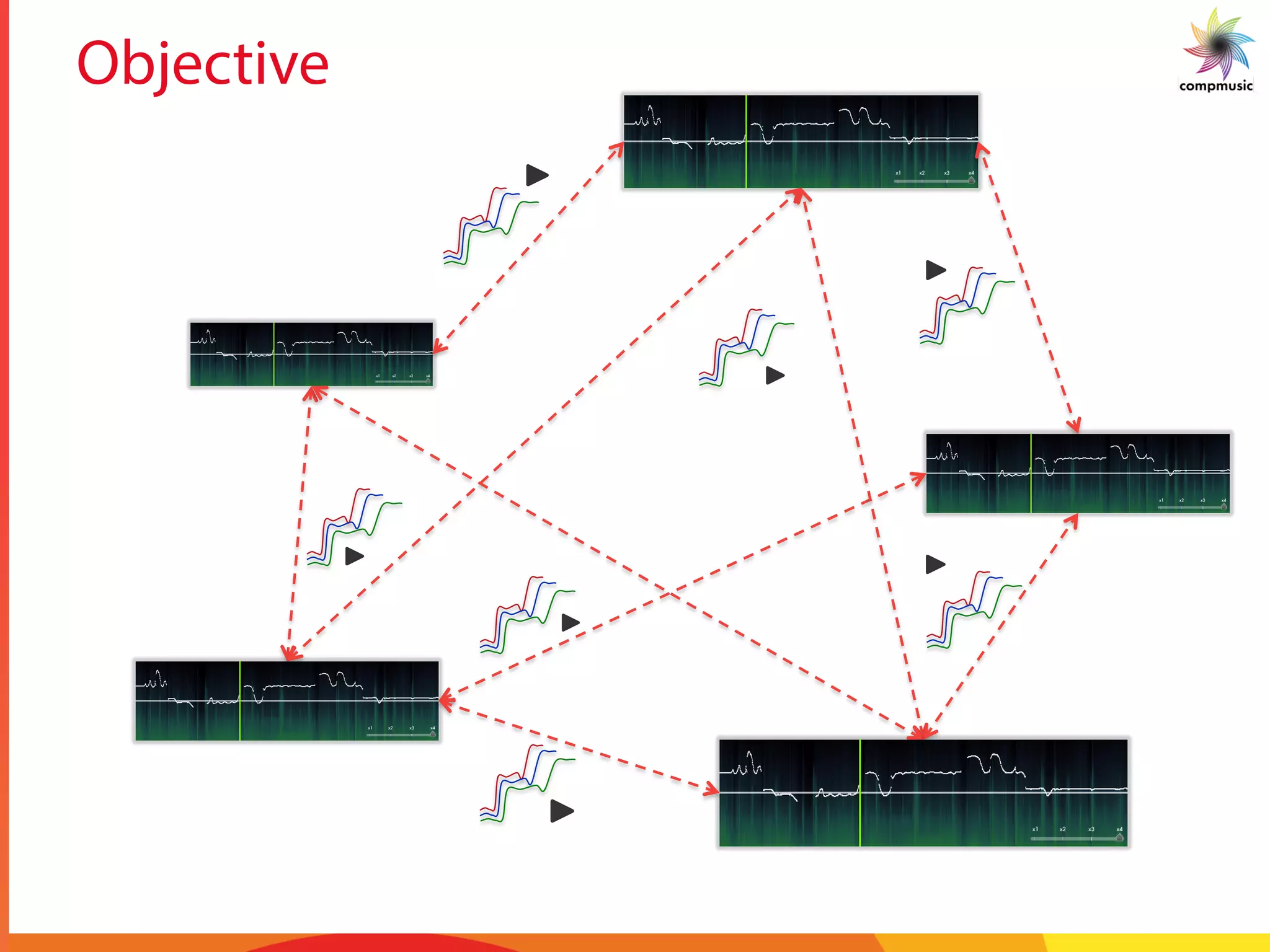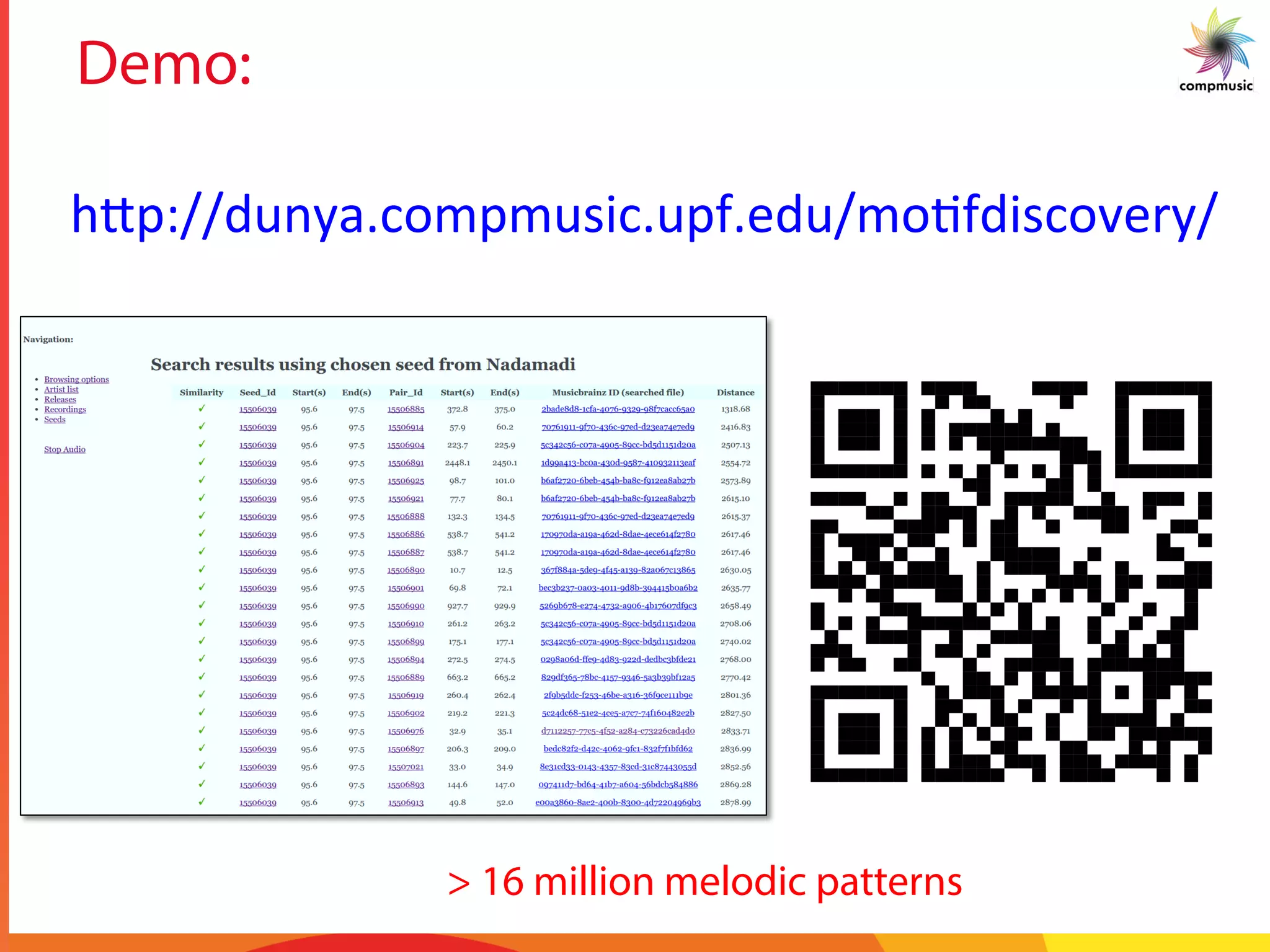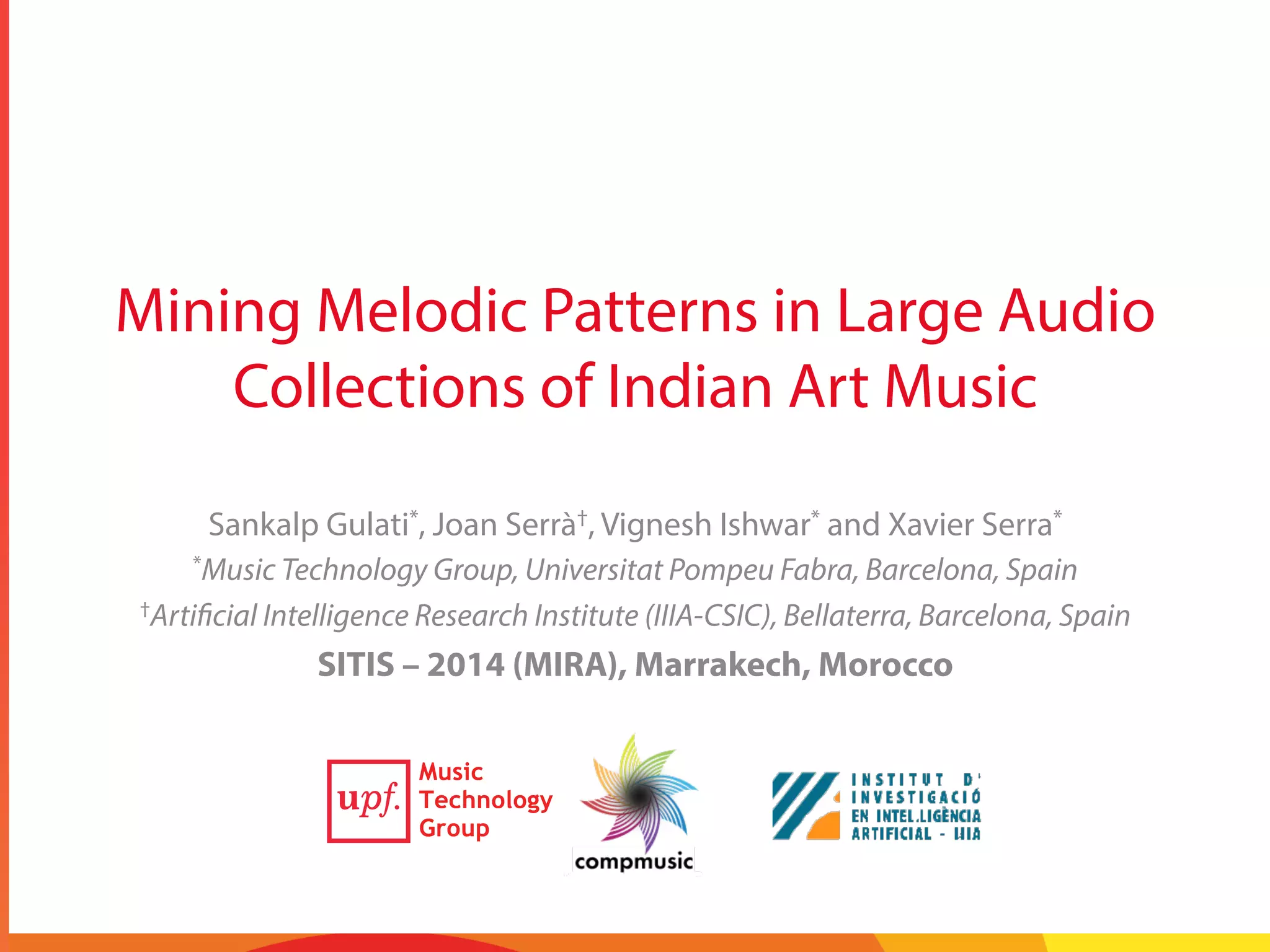The document discusses a comprehensive methodology for identifying melodic patterns in large audio collections of Indian art music, specifically focusing on Carnatic and Hindustani traditions. It outlines the challenges of melodic improvisation and presents a series of signal processing techniques for automatic motif spotting within the music. Utilizing a significant dataset, the study aims to enhance music search and discovery through efficient computational methods.

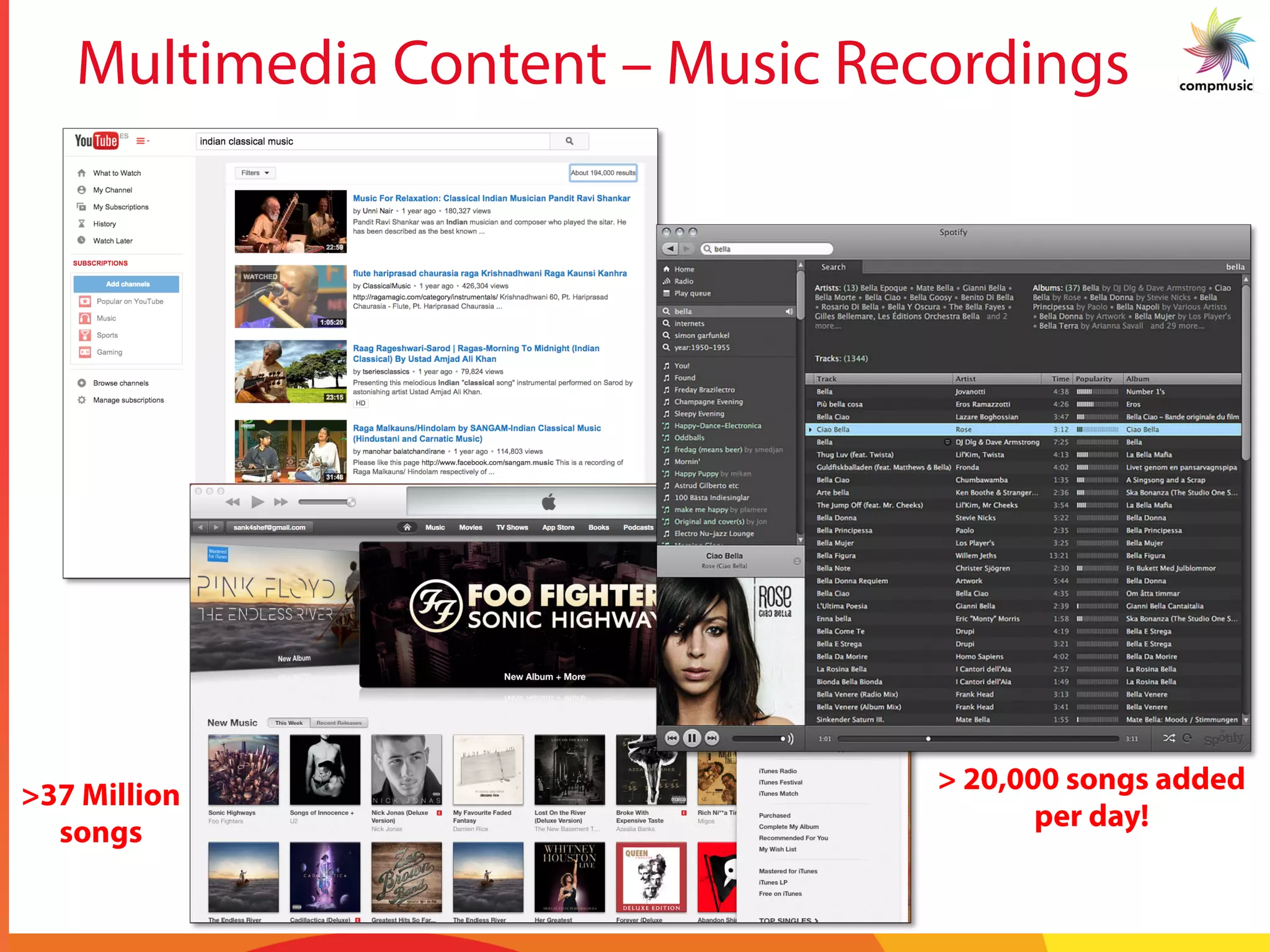
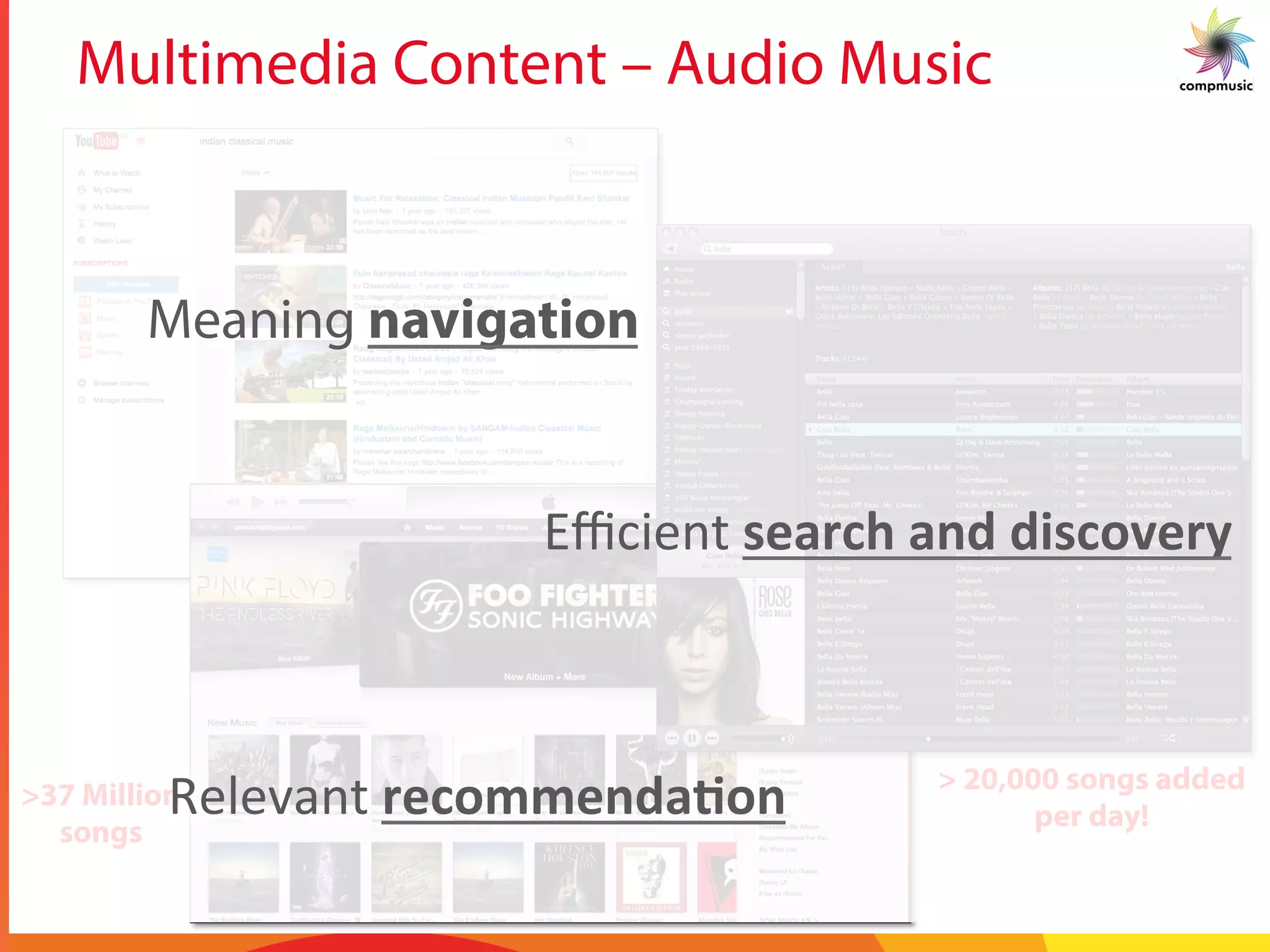

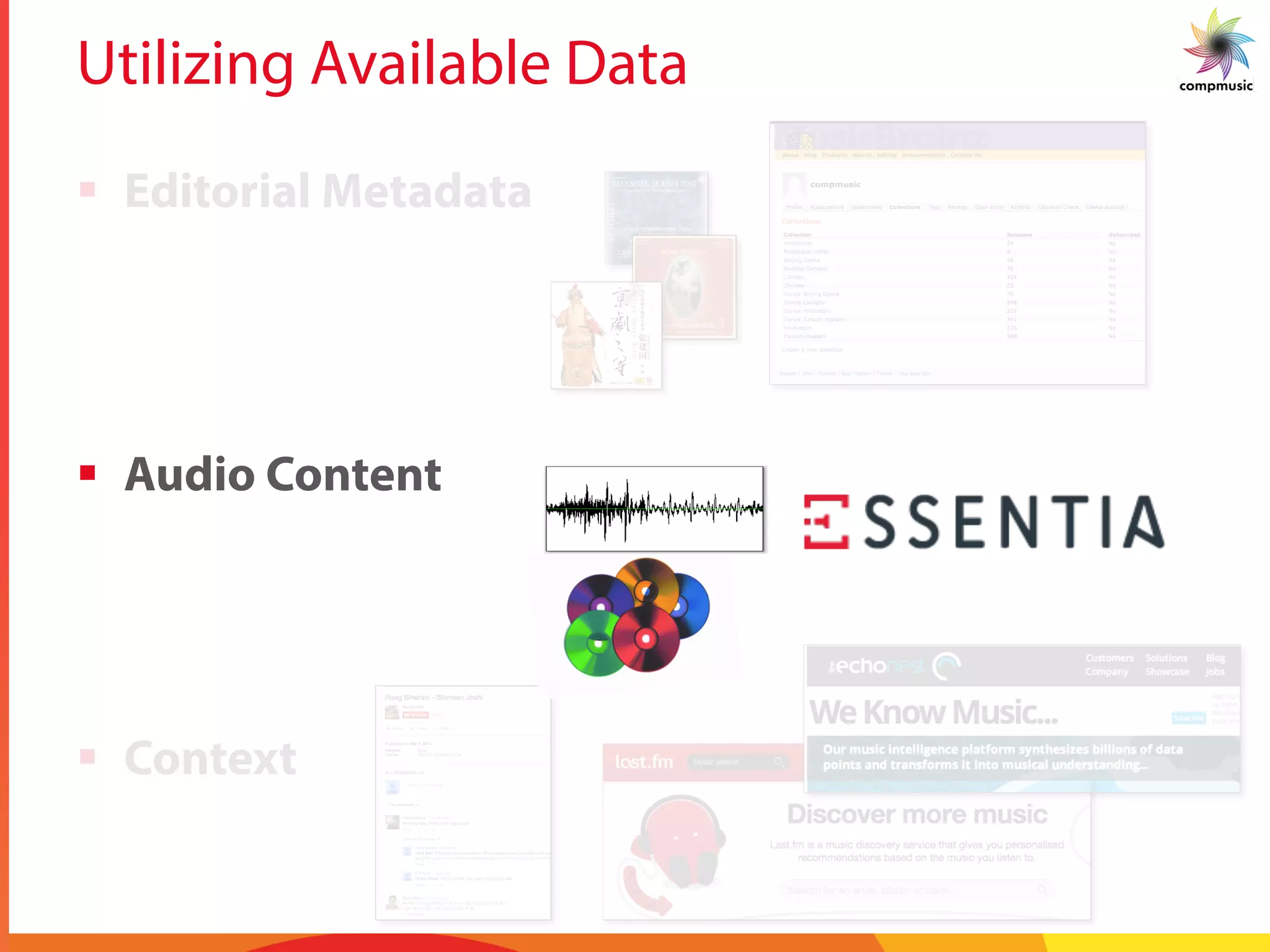
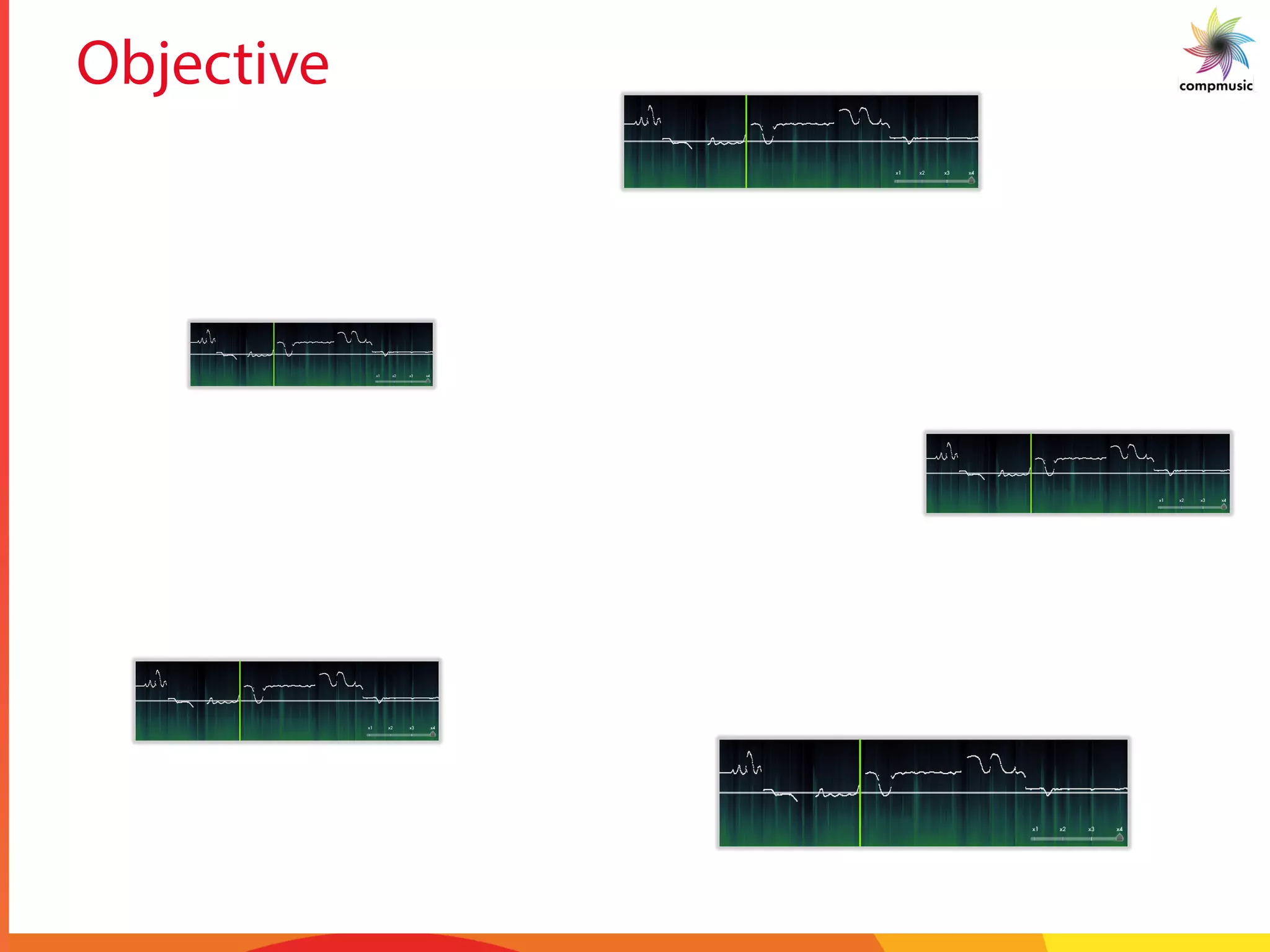
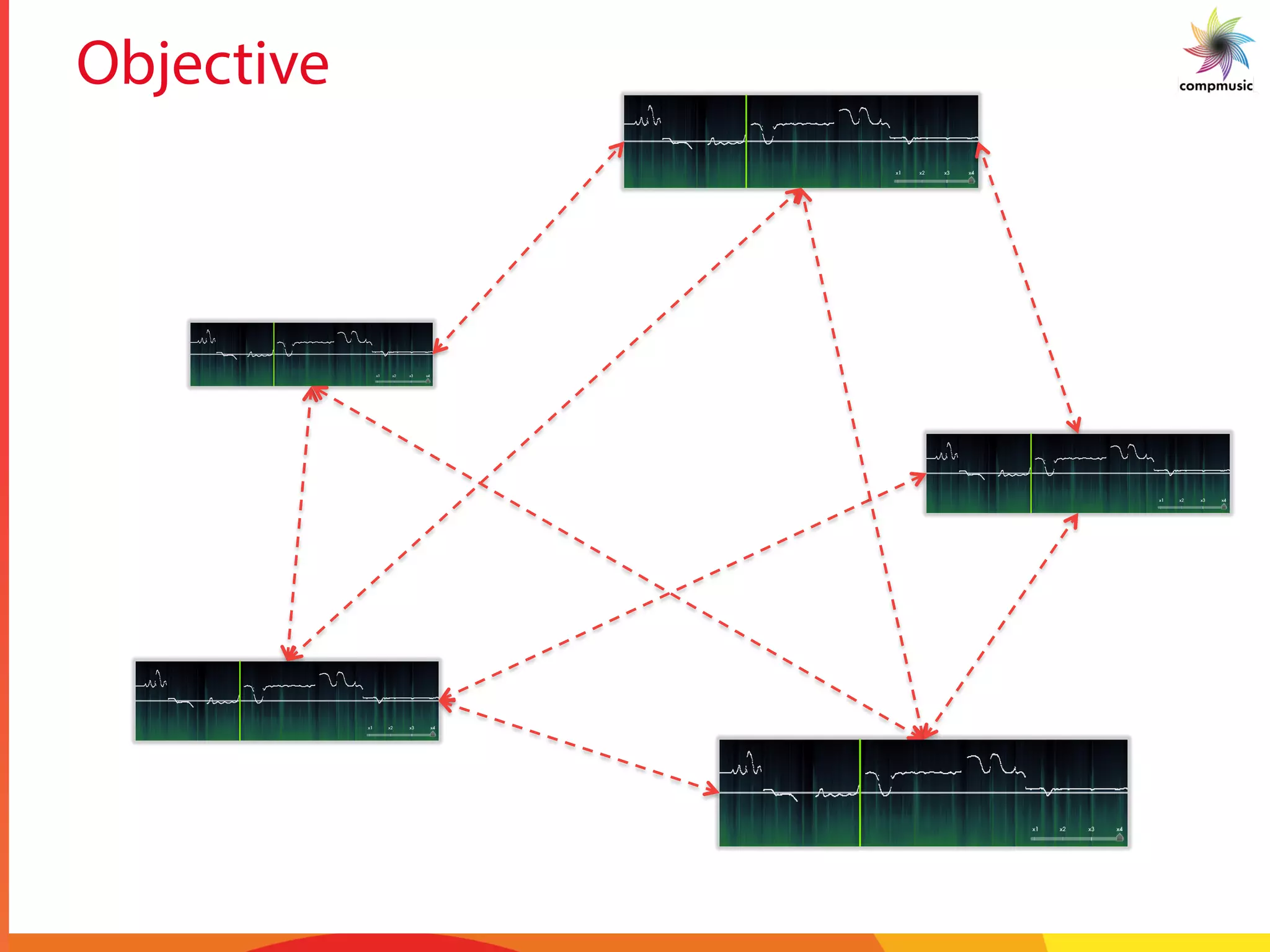


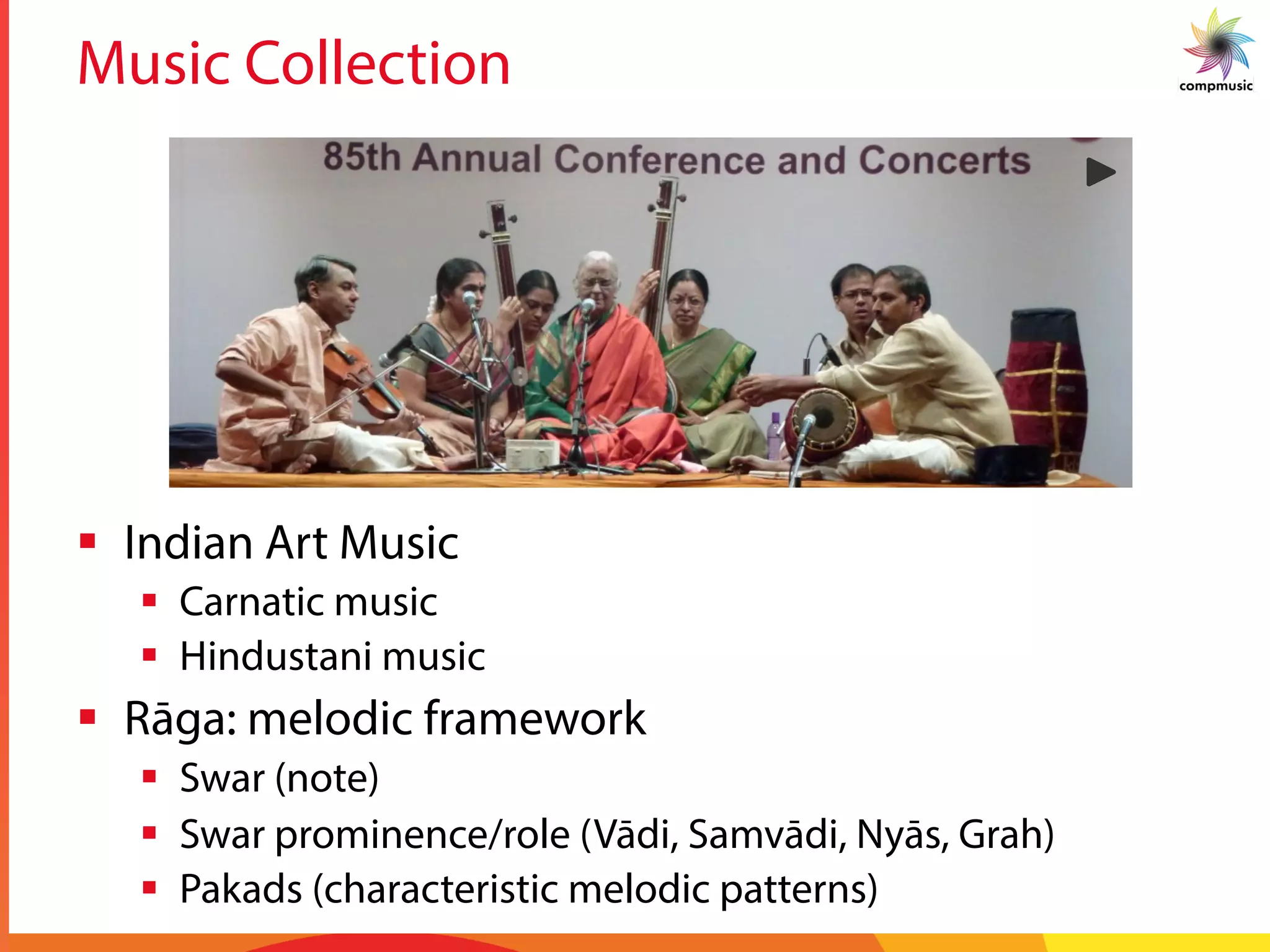

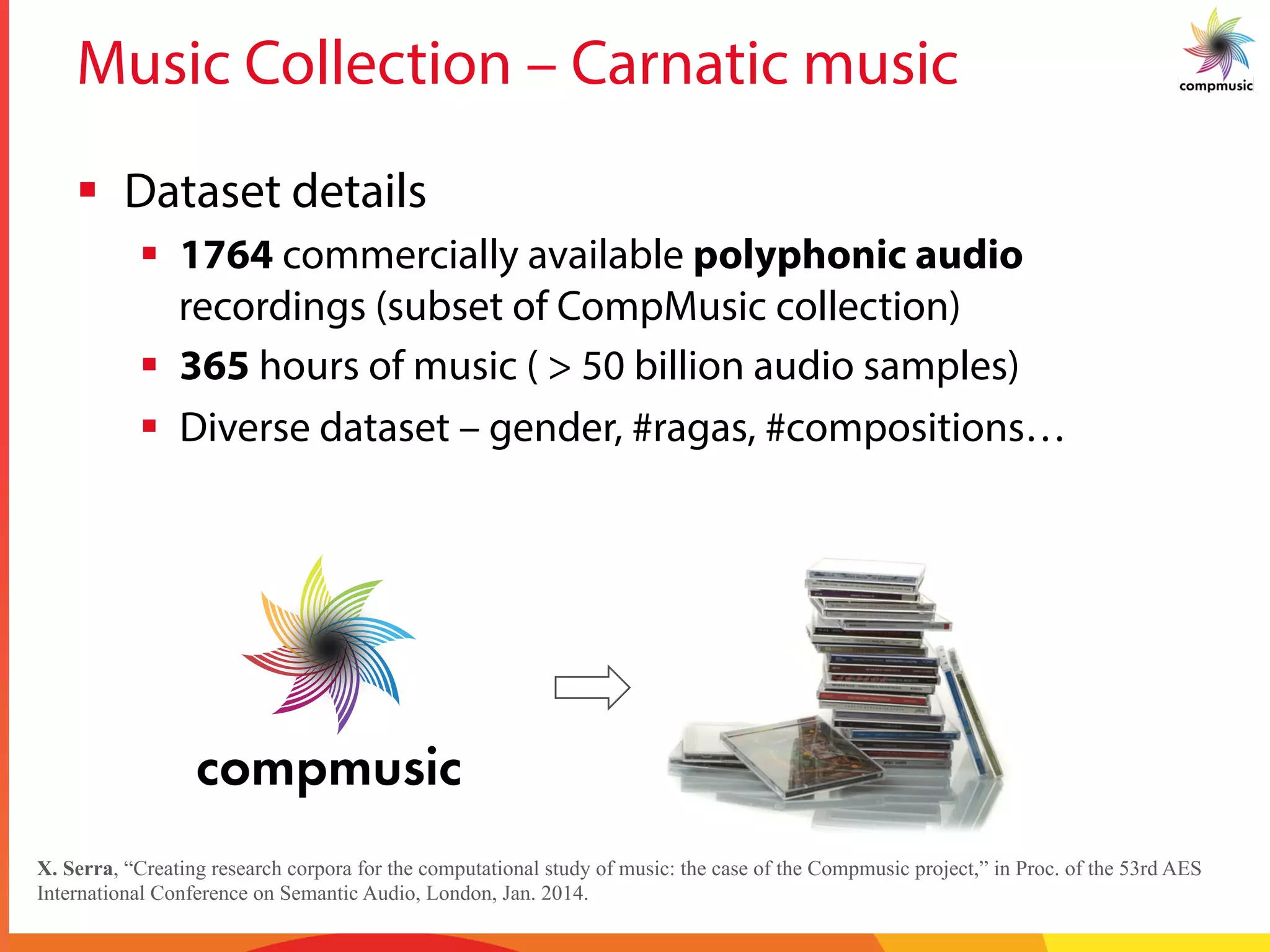
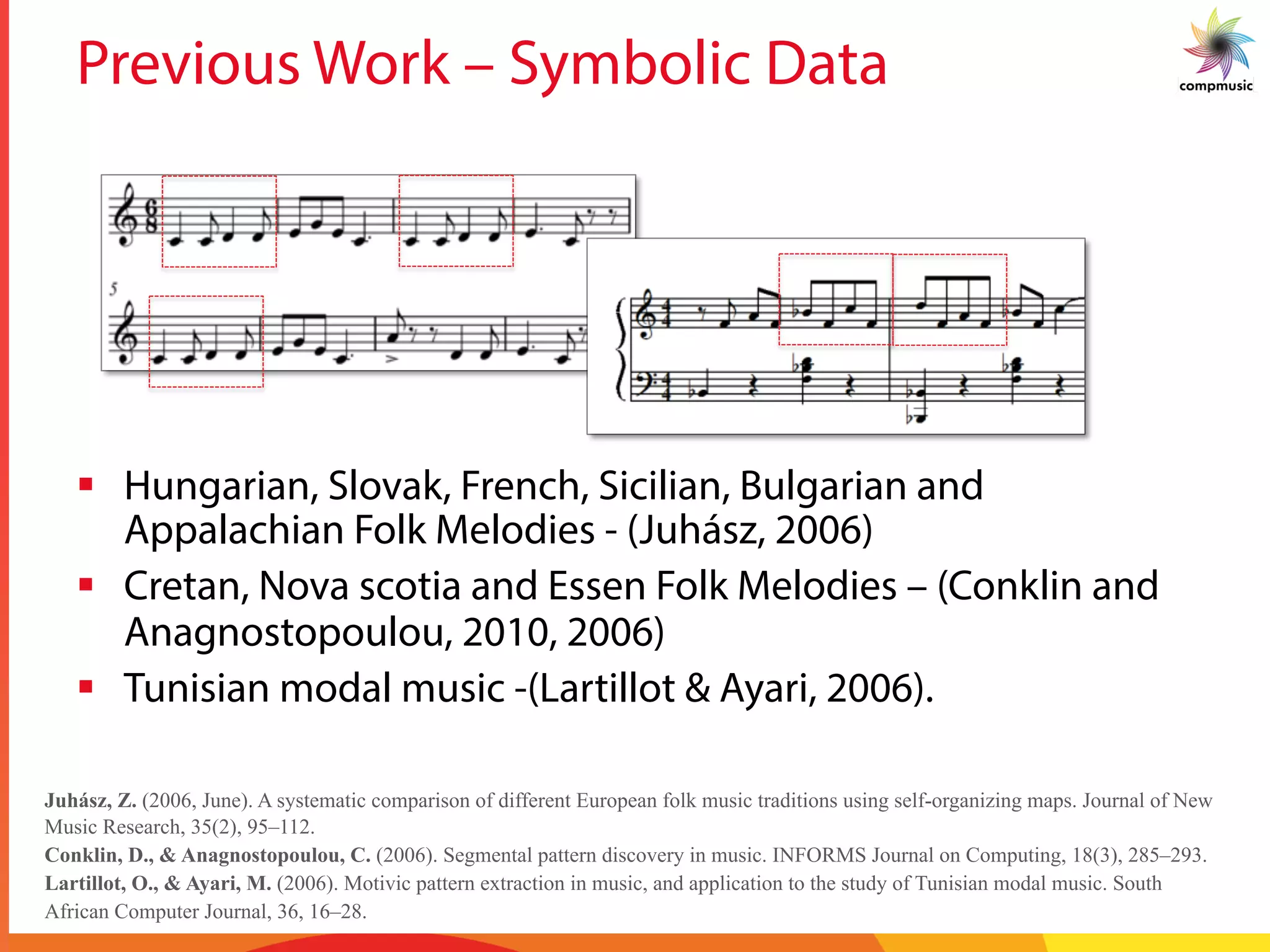
![Previous Work – Audio Data (IAM)
§ Spotting motifs in Carnatic Music
§ Detecting melodic motifs in Hindustani music
§ Classification of melodic motifs
§ Discovering typical melodic motifs from one-liners
ical music us-
17] has exten-
sing pitch his-
ove prove the
ure for compu-
he characteris-
t motif recog-
nuation, in this
en a long Ala-
motif recogni-
c. J.C. Ross et.
ycle 2
empha-
cussion instru-
another work,
n a Bandish (a
sing elongated
valent to find-
erestingly, the
lative duration
The attempt in
series and em-
to identify the
the properties
ime series mo-
anav et. al. in
attempt motif
3, 18], time se-
om projection
es data. In [2],
mbling distance
treaming data.
usic matching
Common Sub-
ngest Common
me series motif
r a 2-3 second
min Alapana
erroneous, ow-
conclusions are presented in Section 6.
2. SADDLE POINTS
2.1 Saddle Points: Reducing the Search Space
0 1 2 3 4
−1000
0
1000
2000
Time in Minutes
FrequencyinCents
Pitch Contour of an Alapana
0 0.5 1
600
800
1000
1200
1400
Time in Seconds
FrequencyinCents
Motif1
0 0.5 1
600
800
1000
1200
1400
Time in Seconds
FrequencyinCents
Motif2
0 0.5 1
600
800
1000
1200
1400
Time in Seconds
FrequencyinCents
Motif3
Figure 2. a) Motifs Interspersed in an Alapana ; b) Mag-
nified Motif
The task of this paper is to attempt automatic spotting
of a motif that is queried. The motif is queried against a set
of Alapanas of a particular raga to obtain locations of the
occurrences of the motif. The task is non-trivial since in
Alapanas, rhythm is not maintained by a percussion instru-
ment. Figure 2 (a) shows repetitive occurrences of motifs
in a piece of music. An enlarged view of the motif is given
in Figure 2(b). Since the Alapana is much longer than the
motif, searching for a motif in an Alapana is like searching
for a needle in a haystack. After an analysis of the pitch
contours and discussions with professional musicians, it
was conjectured that the pitch contour can be quantized at
saddle points. Figure 3 shows an example phrase of the
raga Kamboji with the saddle points highlighted.
Musically, the saddle points are a measure of the extent
V. Ishwar, S. Dutta, A. Bellur, and H. Murthy, “Motif spotting in an Alapana in Carnatic music,” in Proc. of Int. Conf. on Music Information
Retrieval (ISMIR), 2013, pp. 499–504.
J. C. Ross, T. P. Vinutha, and P. Rao, “Detecting melodic motifs from audio for Hindustani classical music,” in Proc. of Int. Conf. on Music
Information Retrieval (ISMIR), 2012, pp. 193–198.
P. Rao, J. C. Ross, K. K. Ganguli, V. Pandit, V. Ishwar, A. Bellur, and H. A. Murthy, “Classification of melodic motifs in raga music with
time-series matching,” Journal of New Music Research, vol. 43, no. 1, pp. 115–131, Jan. 2014.](https://image.slidesharecdn.com/2014sitismirapresentation-170910123015/75/Mining-Melodic-Patterns-in-Large-Audio-Collections-of-Indian-Art-Music-14-2048.jpg)
![Previous Work – Time Series Analysis
§ Motif Discovery approaches
§ Exact, Online, Probabilistic discovery
§ Lower bounding (indexing techniques)
§ Symbolic representation - SAX
§ Lower bounds on dynamic time warping (DTW)
kshop on Research Issues in Data Mining and Knowledge Discovery, 2003 page 4
1 is of little utility, since the
ated in main memory may be
lution that would have been
owever, one had a symbolic
ing of the true distance, one
ric time series data mining
orithms, definitions and data
for discrete data, including
x trees. This is exactly the
ur symbolic representation of
regate approXimation), and
C APPROACH
y length n to be reduced to a
n, typically w << n). The
eger a, where a > 2. Table 2
sed in this and subsequent
oximation of a time series
time series wccC ˆ,...,ˆˆ
1!
s representing time series
phabet = {a,b,c}, a = 3)
notation used in this paper
dimensions, the data is divided into w equal sized “frames.” The
mean value of the data falling within a frame is calculated and a
vector of these values becomes the data-reduced representation.
The representation can be visualized as an attempt to approximate
the original time series with a linear combination of box basis
functions as shown in Figure 3.
Figure 3: The PAA representation can be visualized as an attempt
to model a time series with a linear combination of box basis
functions. In this case, a sequence of length 128 is reduced to 8
dimensions
The PAA dimensionality reduction is intuitive and simple, yet has
been shown to rival more sophisticated dimensionality reduction
techniques like Fourier transforms and wavelets [22, 23, 35].
We normalize each time series to have a mean of zero and a
standard deviation of one before converting it to the PAA
0 2 0 4 0 6 0 8 0 1 0 0 1 2 0
-1 .5
-1
-0 .5
0
0 .5
1
1 .5
c 1
c 2
c 3
c 4
c 5
c 6
c 7
c 8
C
C
A. Mueen, E. Keogh, Q. Zhu, S. Cash, and B. Westover, “Exact discovery of time series motifs,” in Proc. of SIAM Int. Con. on Data
Mining (SDM), 2009, pp. 1–12.
B. Chiu, E. Keogh, and S. Lonardi, “Probabilistic discovery of time series motifs,” Proc. ninth ACM SIGKDD Int. Conf. Knowl. Discov.
data Min. - KDD ’03, p. 493, 2003.
J. Lin, E. Keogh, S. Lonardi, and B. Chiu, “A symbolic representation of time series, with implications for streaming algorithms,” Proc.
8th ACM SIGMOD Work. Res. issues data Min. Knowl. Discov. - DMKD ’03, p. 2, 2003.
T. Rakthanmanon, B. Campana, A. Mueen, G. Batista, B. Westover, Q. Zhu, J. Zakaria, and E. Keogh, “Addressing big data time
series: mining trillions of time series subsequences under dynamic time warping,” ACM Transactions on Knowledge Discovery from Data
(TKDD), vol. 7, no. 3, pp. 10:1–10:31, Sep. 2013.](https://image.slidesharecdn.com/2014sitismirapresentation-170910123015/75/Mining-Melodic-Patterns-in-Large-Audio-Collections-of-Indian-Art-Music-15-2048.jpg)
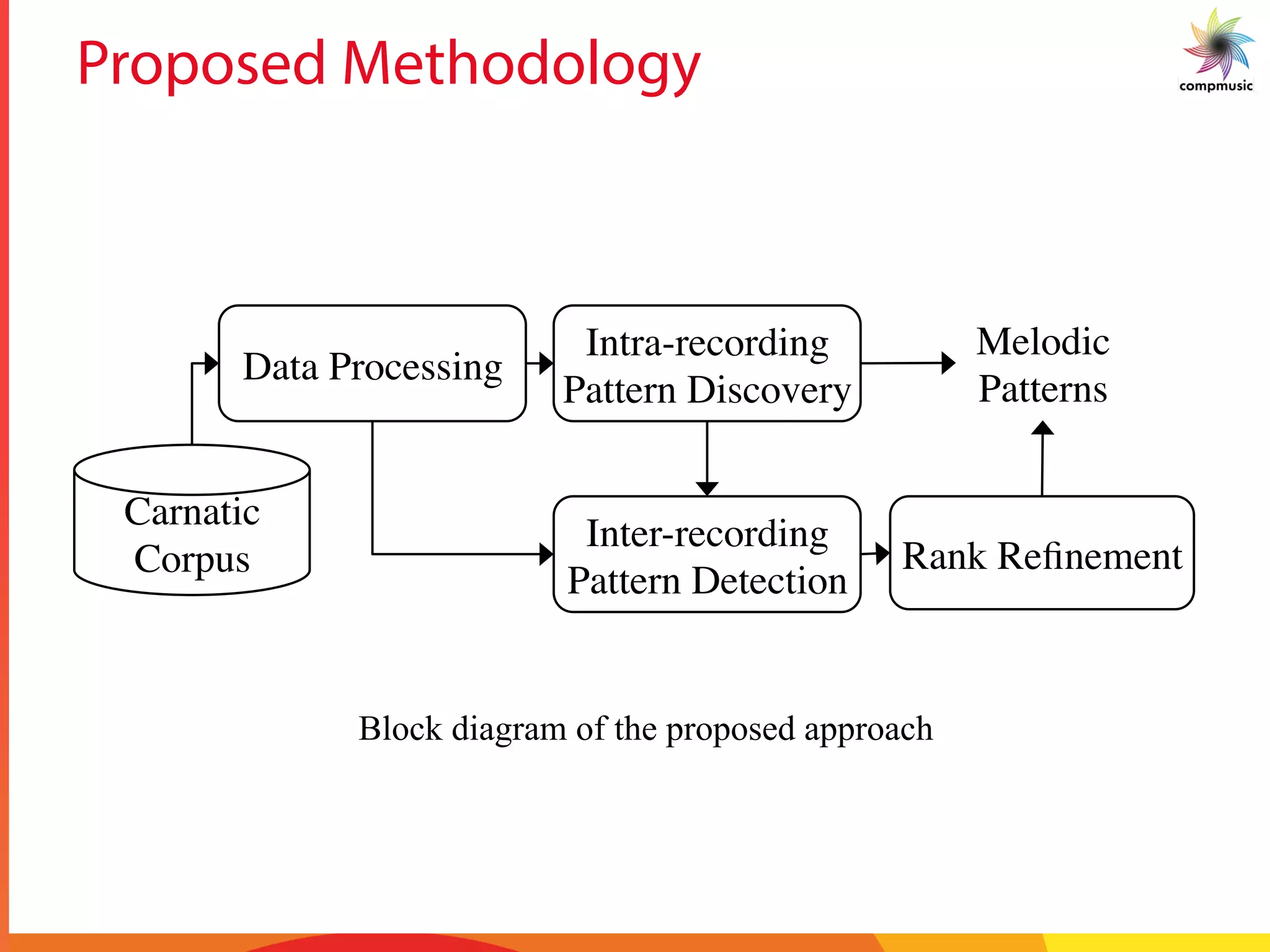
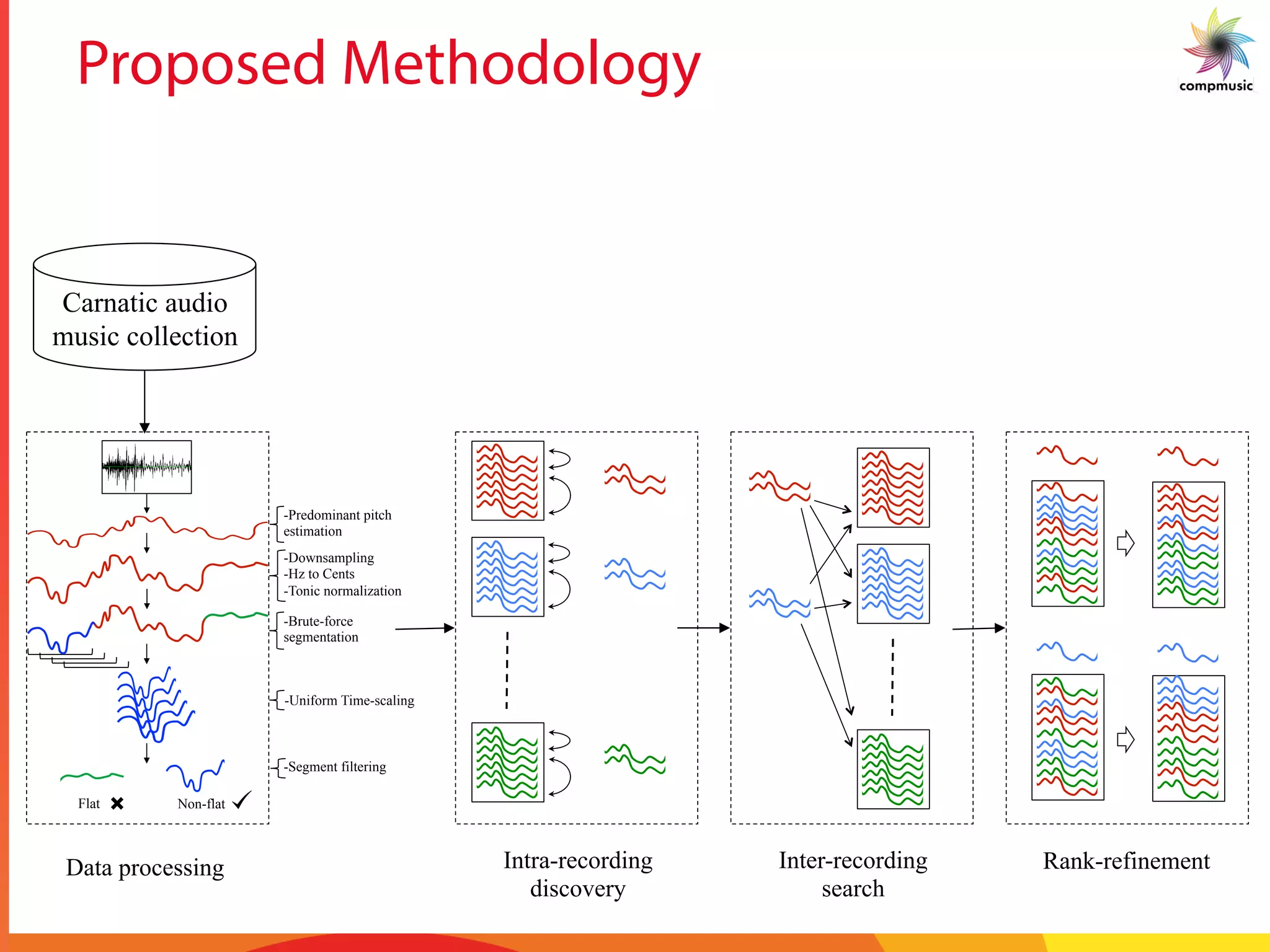
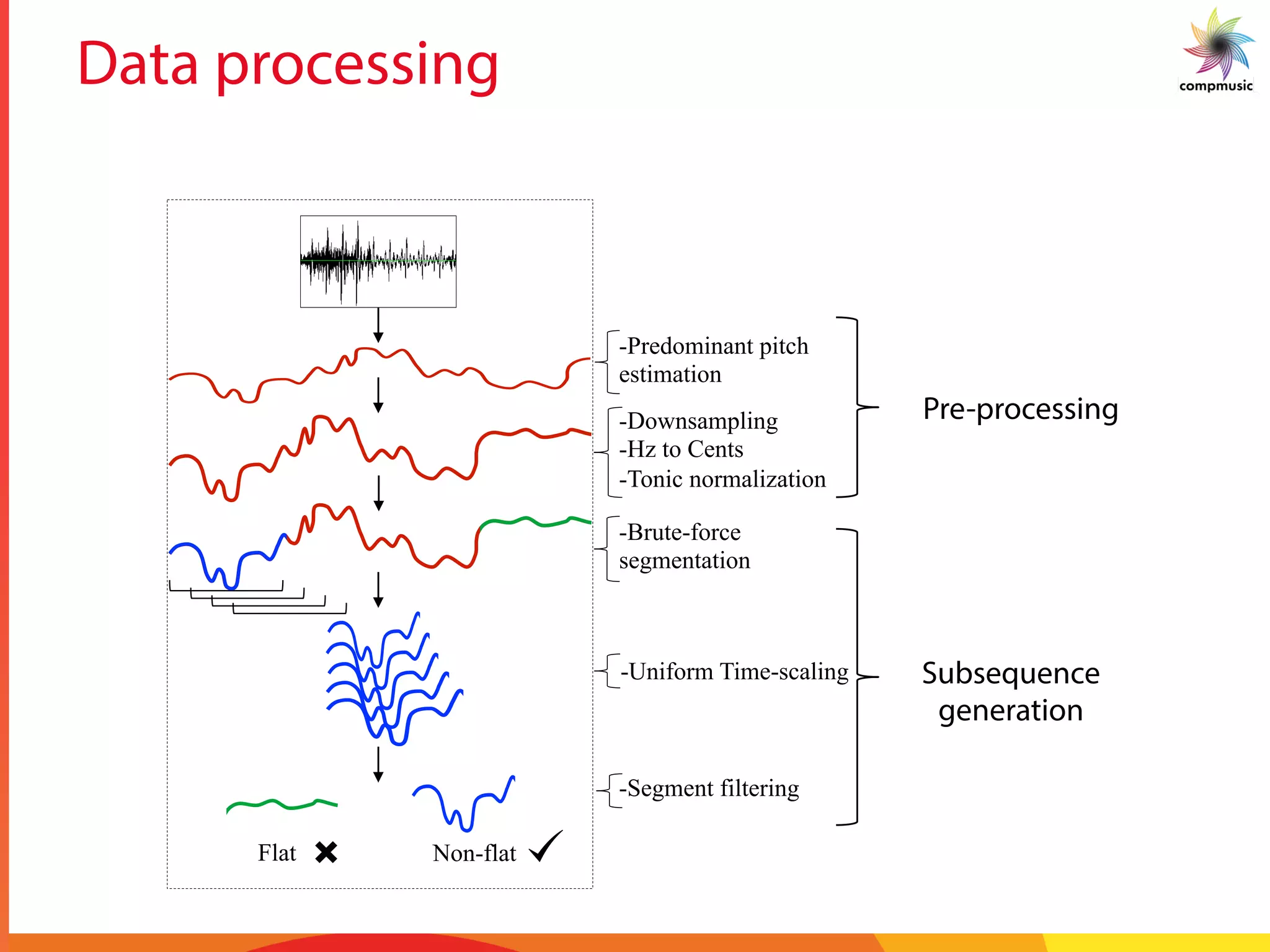
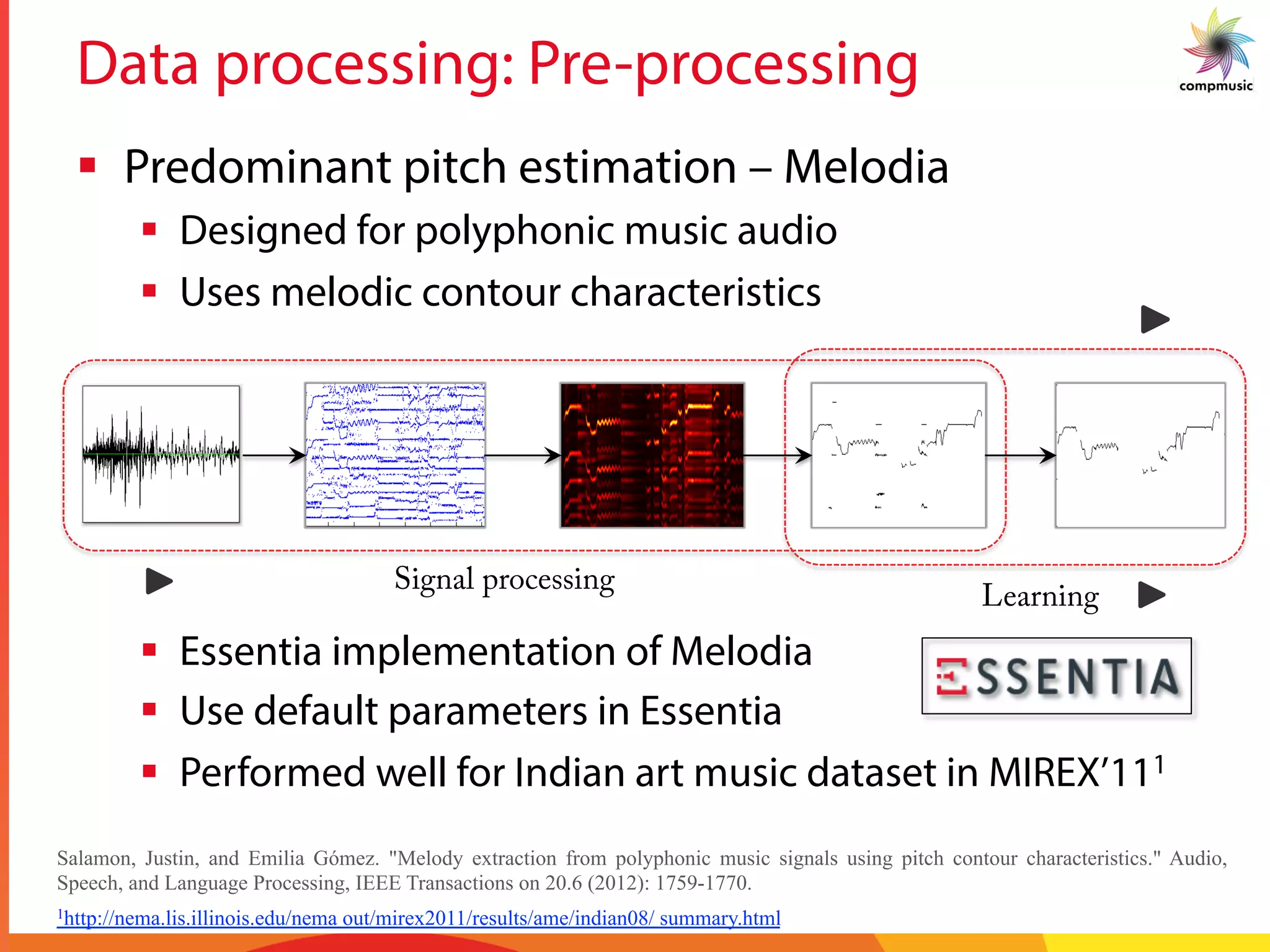
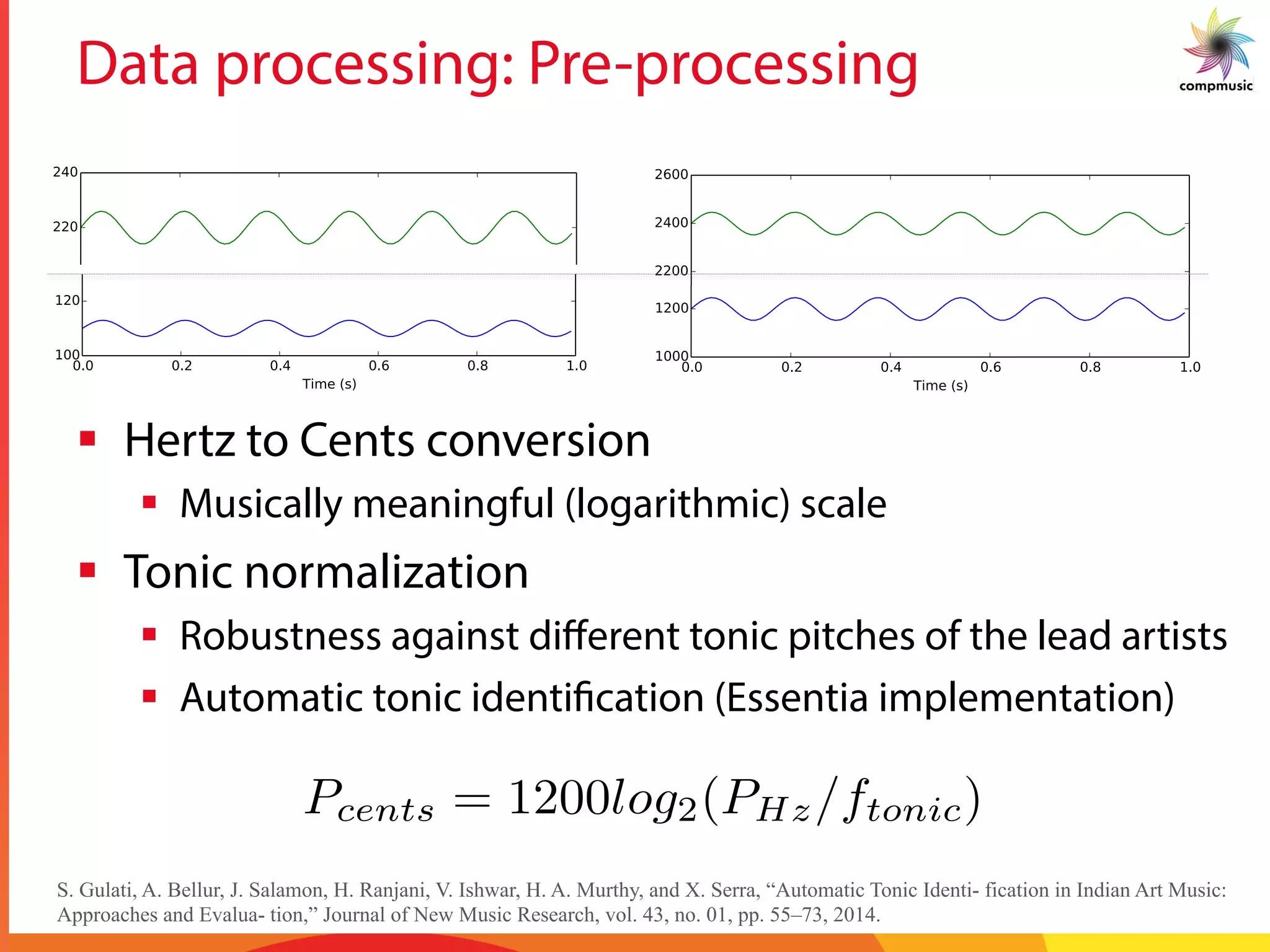
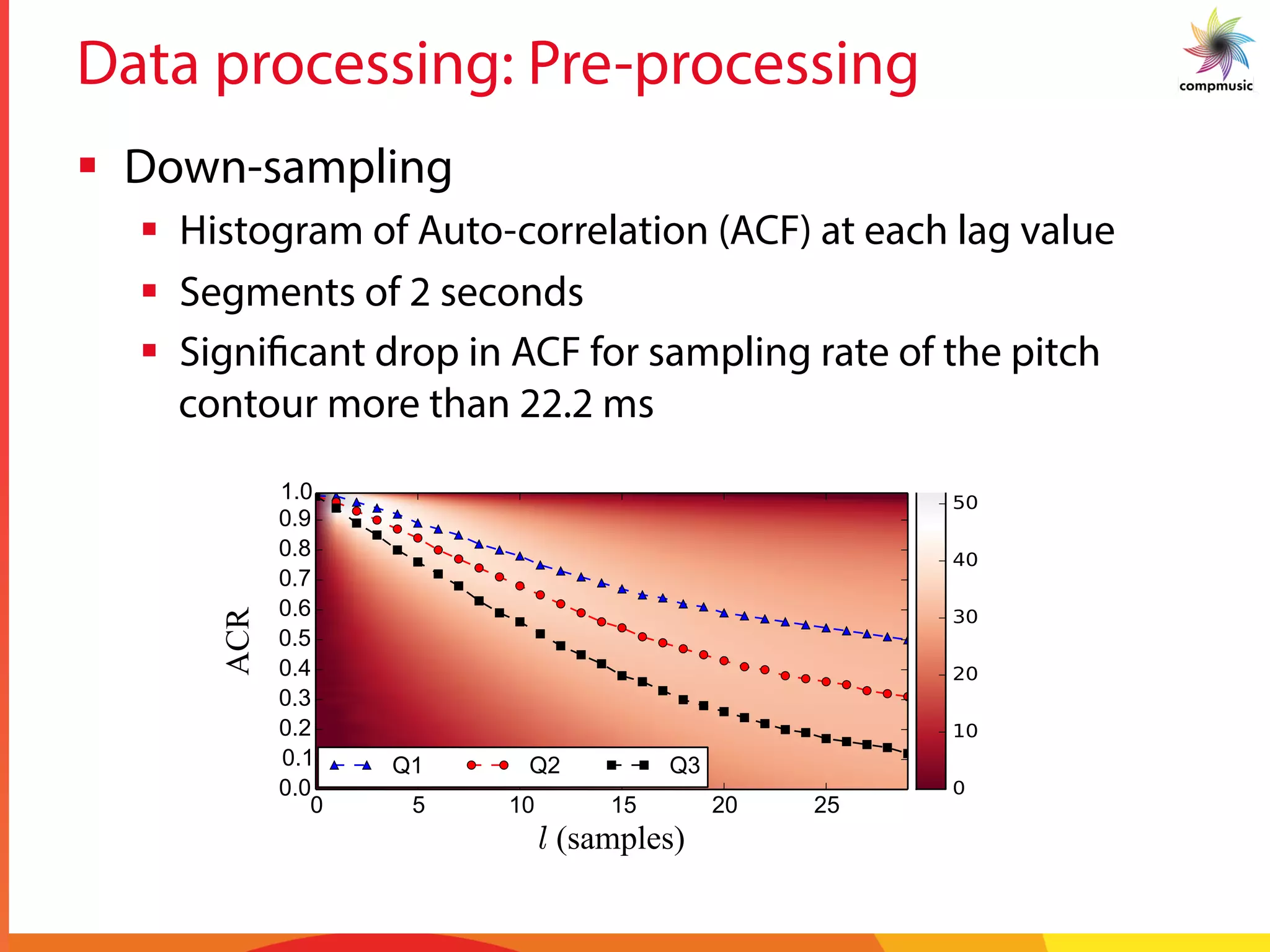

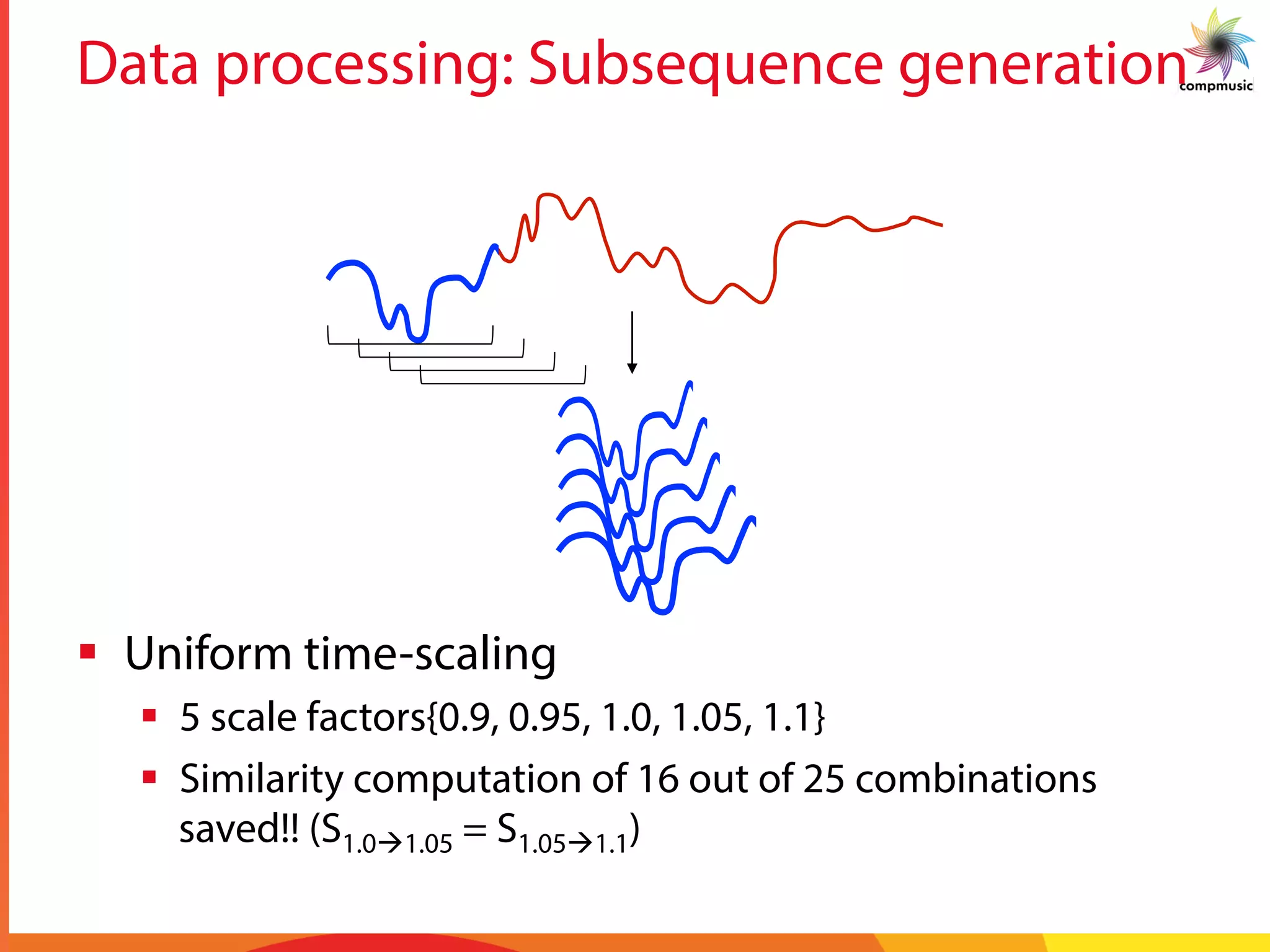

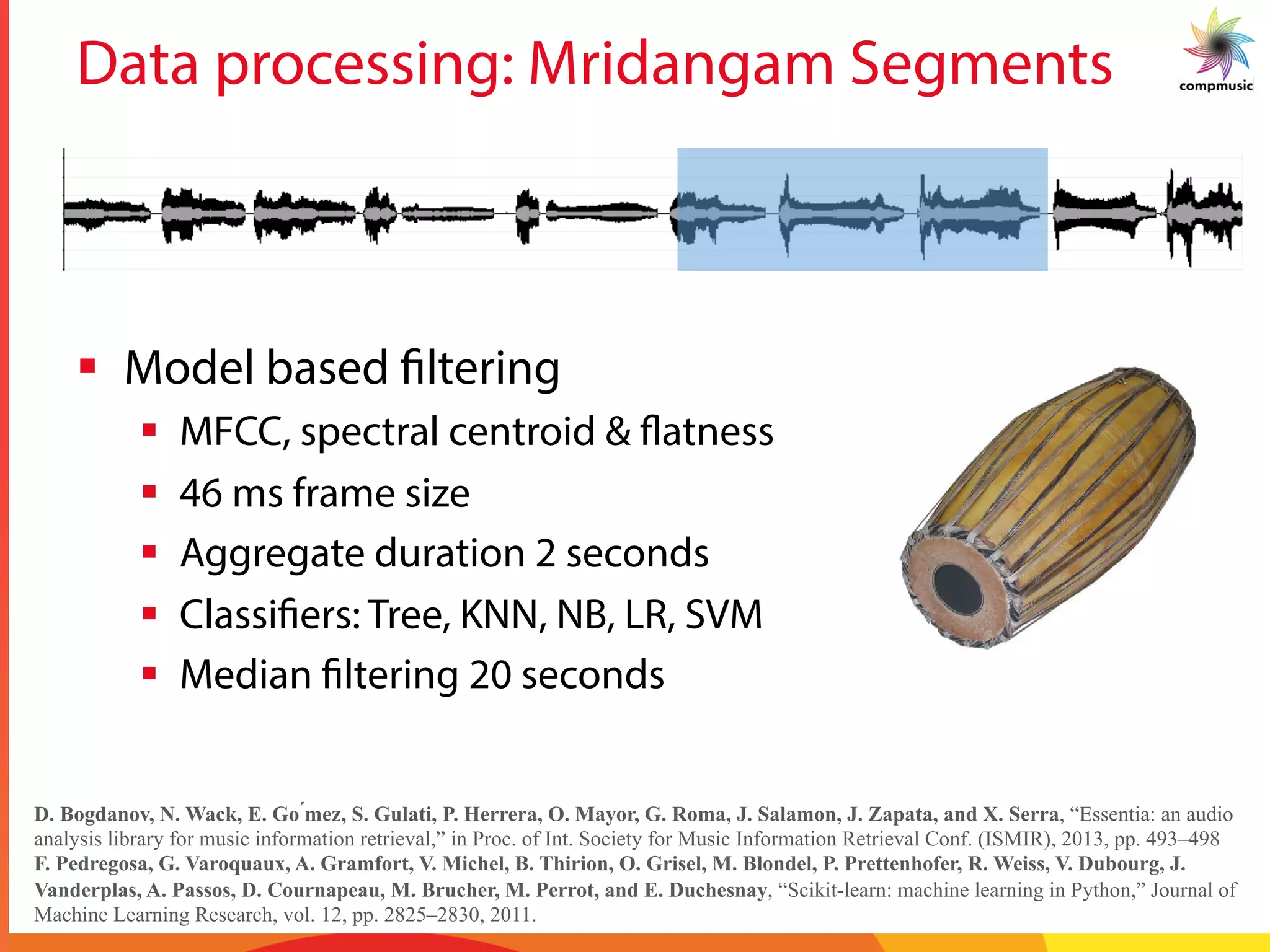
![Intra-recording Discovery
§ Melodic Similarity
§ Dynamic time warping (DTW)
§ Cost matrix – Sq. Euclidean distance
§ 10% Sakoe-Chiba band
§ Step size [(1,0),(1,1),(0,1)]
§ No local constraint or penalties
§ Lower bounds
§ FL bound
§ LB_Keogh_EC / EQ
§ Statistics
§ 25 patterns per song
§ 79,000 total melodic patterns
§ 1.43 trillion similarity computations
§ 76 % computations avoided!!
H. Sakoe and S. Chiba, “Dynamic programming algorithm
optimization for spoken word recognition,” IEEE Trans. on
Acoustics, Speech, and Language Processing, vol. 26, no. 1,
pp. 43–50, 1978.](https://image.slidesharecdn.com/2014sitismirapresentation-170910123015/75/Mining-Melodic-Patterns-in-Large-Audio-Collections-of-Indian-Art-Music-26-2048.jpg)
![Inter-recording Search
§ Melodic Similarity
§ Dynamic time warping (DTW)
§ Cost matrix – Sq. Euclidean distance
§ 10% Sakoe-Chiba band
§ Step size [(1,0),(1,1),(0,1)]
§ No local constraint or penalties
§ Lower bounds
§ FL bound
§ LB_Keogh_EC / EQ
§ Statistics
§ 200 nearest neighbors
§ 15.8 million melodic patterns
§ 12.4 trillion similarity computations
§ 99 % computations avoided!!
H. Sakoe and S. Chiba, “Dynamic programming algorithm
optimization for spoken word recognition,” IEEE Trans. on
Acoustics, Speech, and Language Processing, vol. 26, no. 1,
pp. 43–50, 1978.](https://image.slidesharecdn.com/2014sitismirapresentation-170910123015/75/Mining-Melodic-Patterns-in-Large-Audio-Collections-of-Indian-Art-Music-27-2048.jpg)
![Rank Refinement
§ Melodic Similarity
§ Dynamic time warping (DTW)
§ Cost matrix – 4 distance measures
§ 10% Sakoe-Chiba band
§ Step size [(2,1),(1,1),(1,2)]
§ Local constraint, no penalties
§ No lower bounds
H. Sakoe and S. Chiba, “Dynamic programming algorithm
optimization for spoken word recognition,” IEEE Trans. on
Acoustics, Speech, and Language Processing, vol. 26, no. 1,
pp. 43–50, 1978.](https://image.slidesharecdn.com/2014sitismirapresentation-170910123015/75/Mining-Melodic-Patterns-in-Large-Audio-Collections-of-Indian-Art-Music-28-2048.jpg)
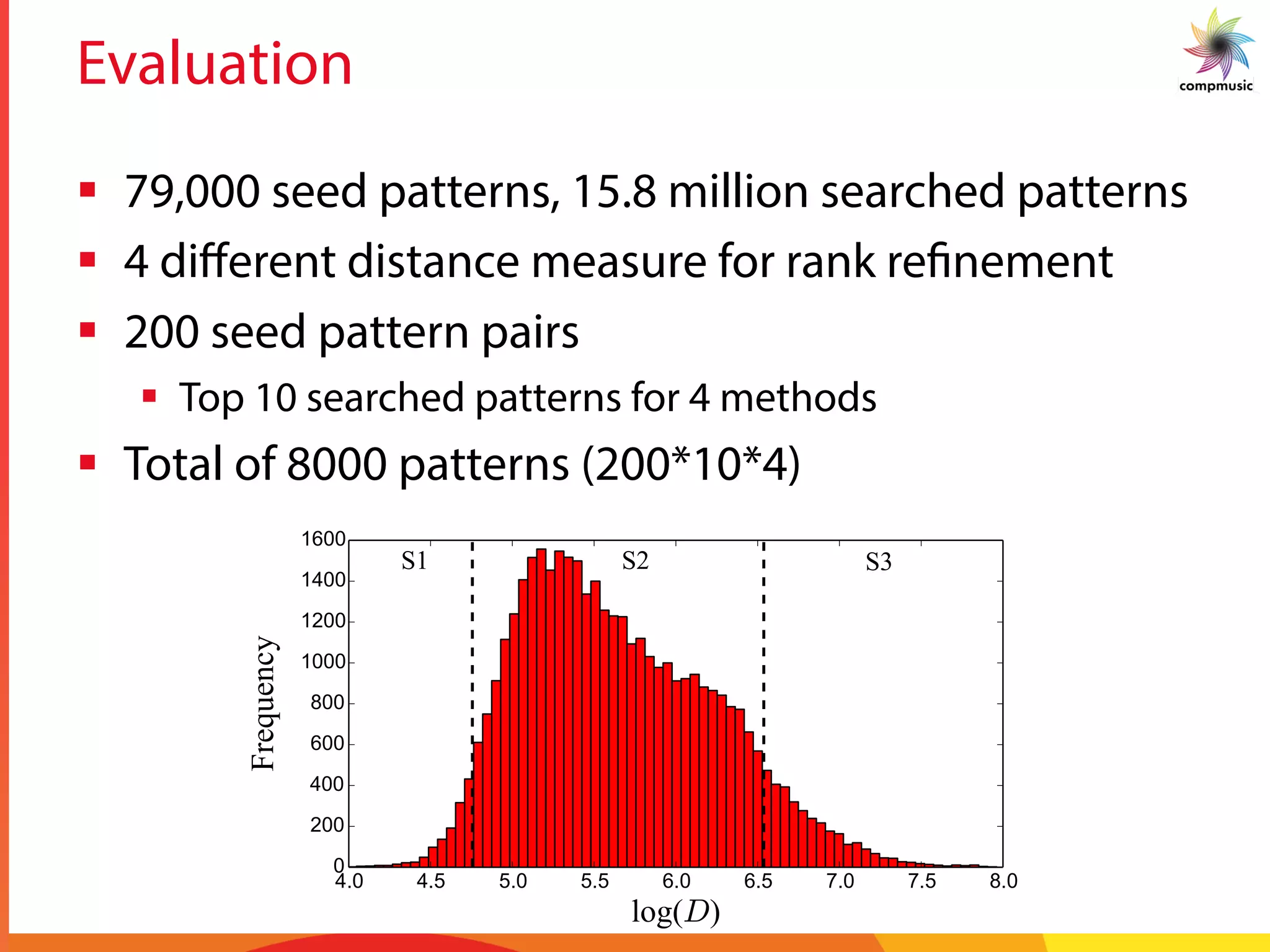
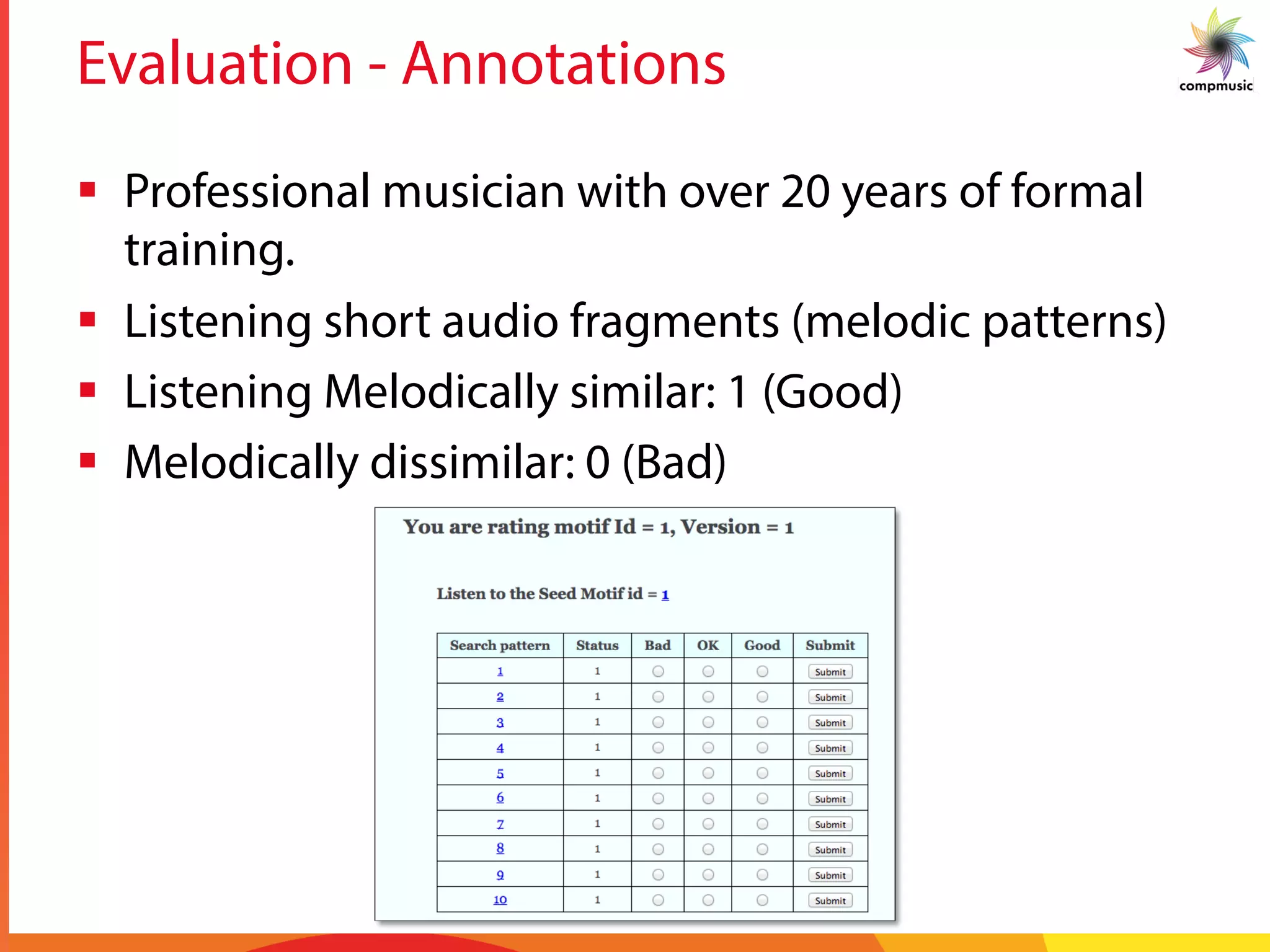
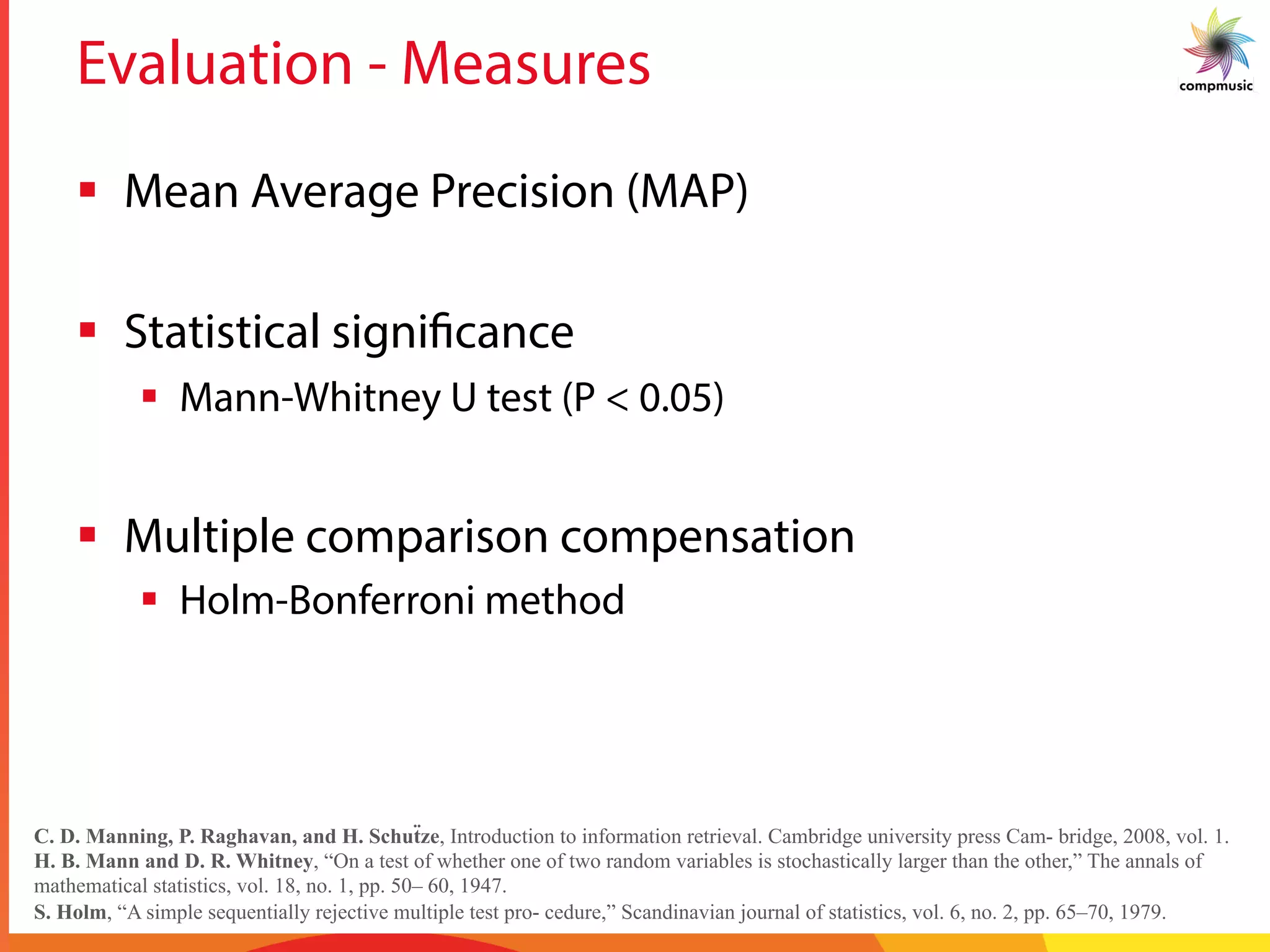
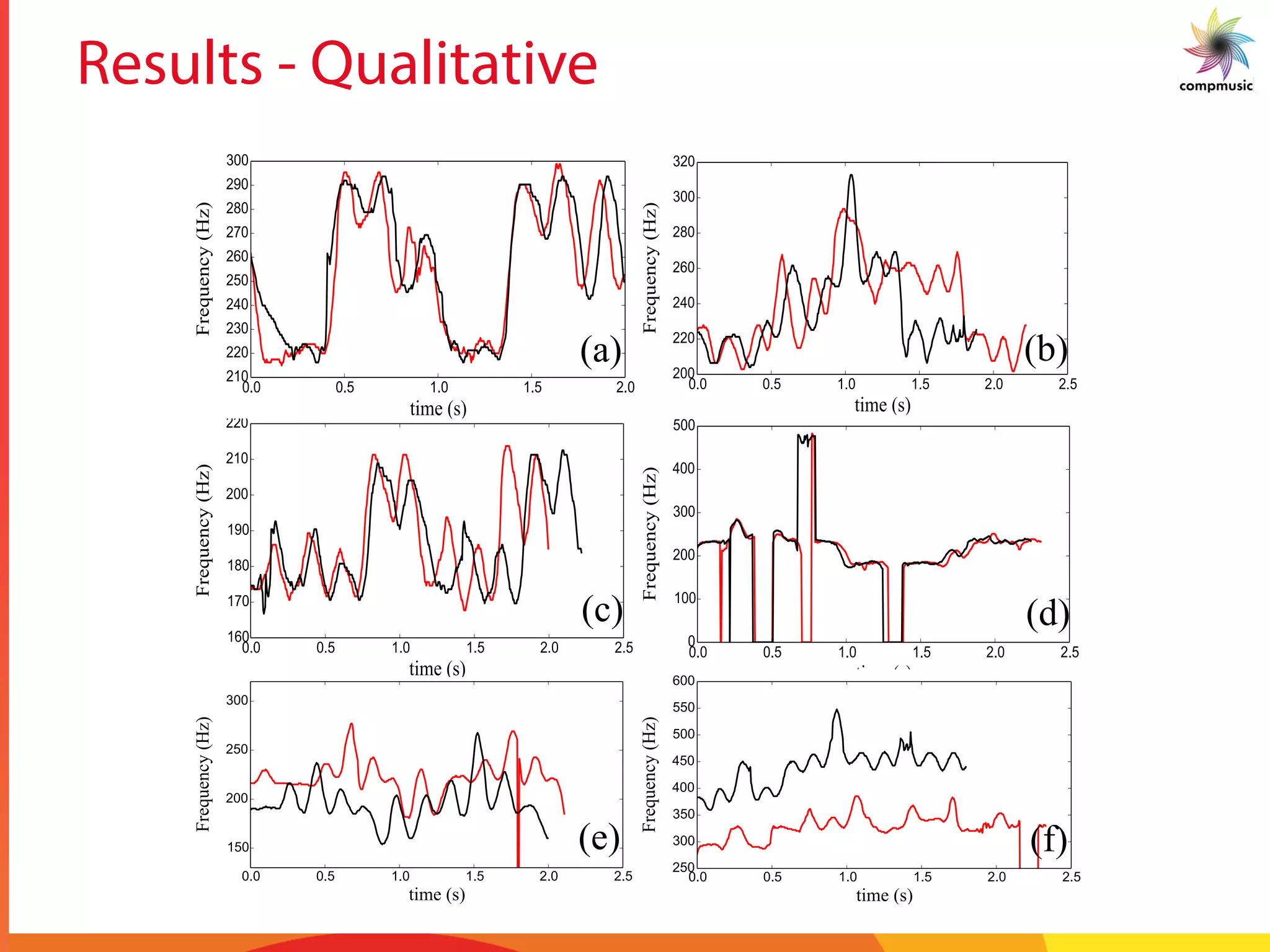
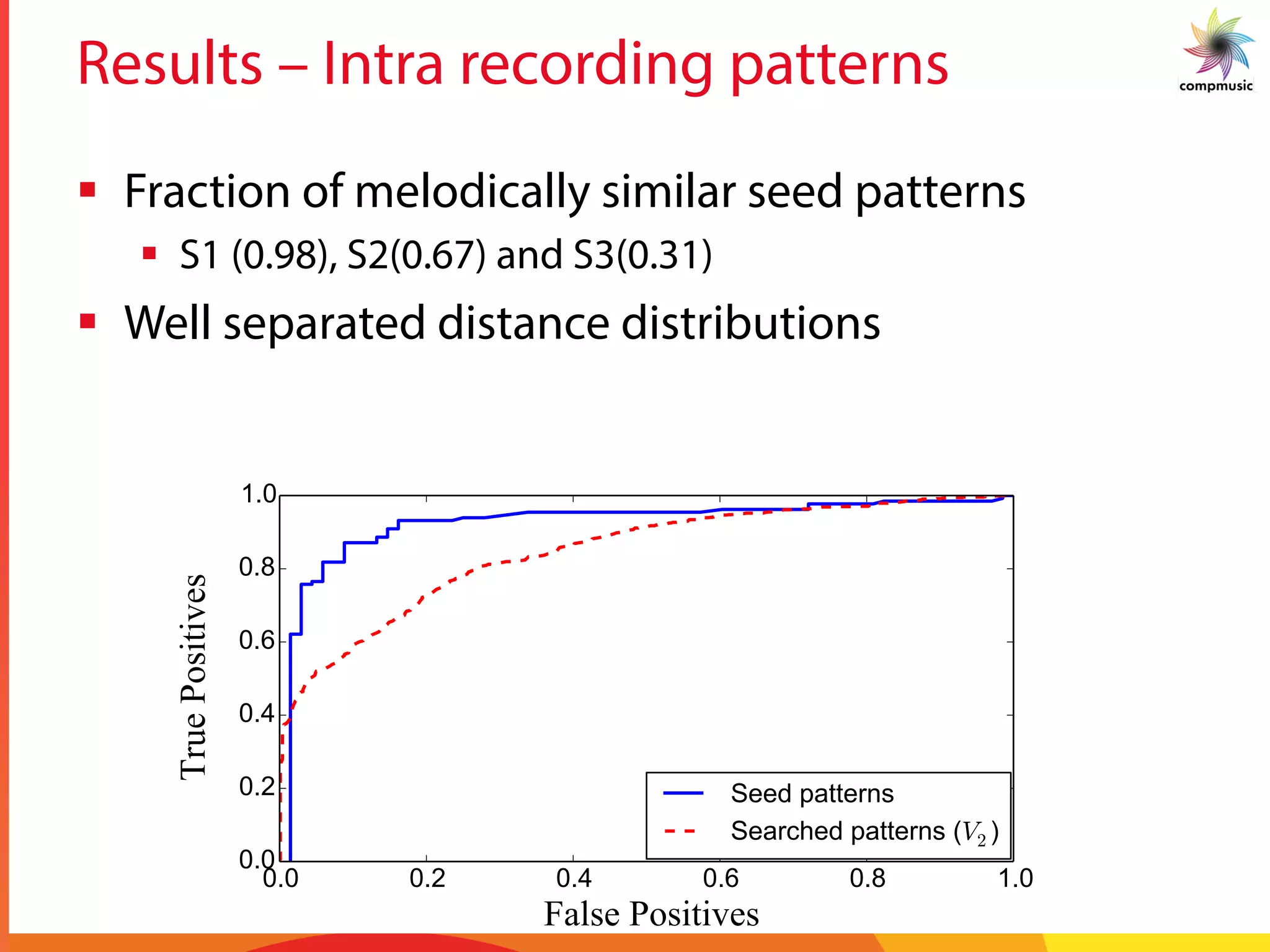
![Results – Inter recording patterns
Table II
MAP SCORES FOR FOUR VARIANTS OF RANK REFINEMENT METHOD
(Vi) FOR EACH SEED CATEGORY (S1, S2 AND S3).
Seed Category V1 V2 V3 V4
S1 0.92 0.92 0.91 0.89
S2 0.68 0.73 0.73 0.66
S3 0.35 0.34 0.35 0.35
bounda
position
analysis
This
search C
work P
grant a
1434 f
from th
CSIC, a
[1] A.
bro
in
Co](https://image.slidesharecdn.com/2014sitismirapresentation-170910123015/75/Mining-Melodic-Patterns-in-Large-Audio-Collections-of-Indian-Art-Music-34-2048.jpg)
![Results – Inter recording patterns
Table II
MAP SCORES FOR FOUR VARIANTS OF RANK REFINEMENT METHOD
(Vi) FOR EACH SEED CATEGORY (S1, S2 AND S3).
Seed Category V1 V2 V3 V4
S1 0.92 0.92 0.91 0.89
S2 0.68 0.73 0.73 0.66
S3 0.35 0.34 0.35 0.35
bounda
position
analysis
This
search C
work P
grant a
1434 f
from th
CSIC, a
[1] A.
bro
in
Co
S1 S2 S3](https://image.slidesharecdn.com/2014sitismirapresentation-170910123015/75/Mining-Melodic-Patterns-in-Large-Audio-Collections-of-Indian-Art-Music-35-2048.jpg)

